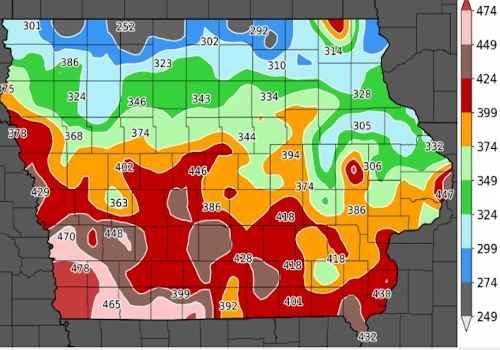By Ashley Dean and Erin Hodgson
Iowa’s most significant soybean insect pest, soybean aphid, has host-alternating biology. Its primary host is buckthorn, an invasive shrub often found in hedgerows and roadside ditches, and its secondary host is soybean. For the majority of the year, soybean aphids exist as cold-hardy eggs on buckthorn branches near leaf buds. As spring temperatures increase, the eggs hatch and a few generations are produced on buckthorn before moving to soybean. In the summer, soybean aphid has multiple, overlapping generations on soybean. During the fall, soybean aphids return to buckthorn.
For many aphids that overwinter as an egg, hatching often happens when the host resumes spring growth. This makes biological sense because the aphids feed on phloem from actively-growing tissue. If egg hatch happens too soon, they can suffer mortality from starvation. Research has confirmed soybean aphid egg hatch happens around the time buckthorn buds swell. Soybean aphid egg hatch occurs between 147-154 degree days (base 50°F) and buckthorn bud swell happens shortly after that (165-171 degree days). Based on air temperatures in 2021 (Figure 1), egg hatch is likely complete in northern Iowa, where most of the buckthorn in Iowa is located.

Figure 1. Accumulated growing degree days (base 50°F) in Iowa from January 1 – May 11, 2021. Map courtesy of Iowa Environmental Mesonet, ISU Department of Agronomy.
Once eggs hatch, soybean aphid has a few (2-3, typically) generations on buckthorn before producing winged morphs that move to early vegetative soybean. The initial colonization of soybean aphid in a field typically occurs in early-mid June and is patchy. Fields near a buckthorn stand are most likely to encounter early season infestations of soybean aphid. Winged soybean aphids may also fly short distances to colonize a new field; however, since they are weak fliers, they move longer distances by gliding along wind currents.
If ideal conditions persist after colonization, soybean aphid can reproduce quickly and become field-wide. Throughout the summer, soybean aphids are all females that reproduce asexually and give live birth to genetic clones of themselves, which lends to rapid population growth. It is important to begin scouting soybeans at V1 and continue every 7-10 days throughout the season to track soybean aphid population growth.
Source : iastate.edu